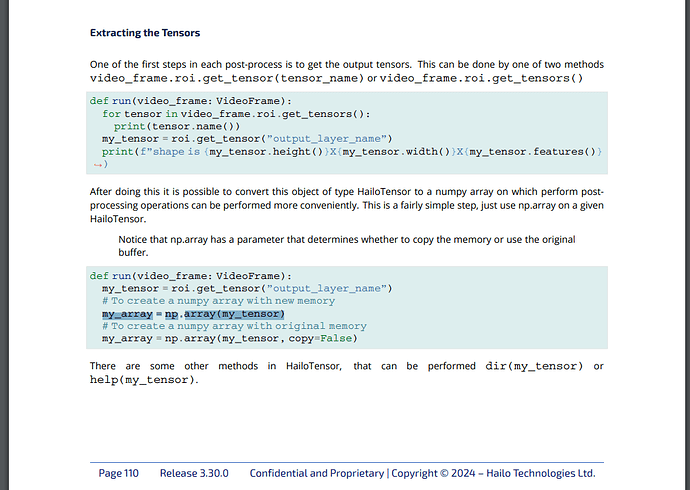@nina-vilela @omria
I am working with hailopython gstreamer element and I am processing yolov8_pose output in python.
I found a way to extract numpy from tensors in TAPPAS DOCS.
But the format seems is different than the format in HailoAsyncInference…
hailonet results are in b/w 0-255
And Hailo Async Callback is float values(Possitive and Negative).
And I am unable to utilize the post process steps for yolov8_pose from here… Hailo-Application-Code-Examples/runtime/python/pose_estimation/pose_estimation_utils.py at main · hailo-ai/Hailo-Application-Code-Examples · GitHub
from typing import Dict
import gi
import numpy as np
gi.require_version('Gst', '1.0')
from gi.repository import Gst
import hailo
from post_process import PoseEstPostProcessing
def run(frame):
"""
Run Post Processing Steps on Hailo Raw Detections.
Resources:
https://github.com/hailo-ai/tappas/blob/master/core/hailo/plugins/python/hailo_python_api_sanity.py
Args:
frame: gsthailo.video_frame.VideoFrame
(https://github.com/hailo-ai/tappas/blob/master/core/hailo/python/gsthailo/video_frame.py).
Returns:
Gst.FlowReturn.OK
"""
print('--------CALLBACK STARTED------------------')
post_process = PoseEstPostProcessing(
max_detections=50,
score_threshold=0.1,
nms_iou_thresh=0.65,
regression_length=15,
strides=[8, 16, 32]
)
# roi = frame.roi
# buffer = frame.buffer
# video_info = frame.video_info
# tensors = roi.get_tensors()
# objects = roi.get_objects()
try:
roi = frame.roi
raw_tensors = roi.get_tensors() # List[hailo.HailoTensor]
objects = roi.get_objects()
tensors: Dict[str, np.array] = {}
for t in raw_tensors:
# print(tensor.name()) # Returns output layer name
layer_name = t.name()
tensor = roi.get_tensor(layer_name)
tensor_np = np.array(tensor)
tensor_np = tensor_np.reshape(1, *tensor_np.shape)
tensors[layer_name] = tensor_np
print(tensor_np)
if len(tensors) != 9:
print("WARNING: tensors does not match with post process step")
return
else:
# result = post_process.post_process(tensors, 640, 640, 1)
result = post_process.post_process(tensors, 640, 640, 1, 17, normalize=True)
# print(result['bboxes'])
# hailo_detections = []
# for (bbox, score, keypts, joint_score) in zip(result['bboxes'], result['scores'], result['keypoints'], result['joint_scores']):
# xmin, ymin, w, h = [float(x) for x in bbox]
# bbox = hailo.HailoBBox(xmin, ymin, w, h)
# detection = hailo.HailoDetection(bbox, 0, score)
# hailo_points = [] # List[hailo.HailoPoint]
# for pt in keypts:
# hailo_points.append(hailo.HailoPoint(pt[0], pt[1], joint_score))
# landmarks = hailo.HailoLandmarks('yolo', hailo_points, 0.0)
# detection.add_object(landmarks)
# roi.add_objects(hailo_detections)
except Exception as err:
print("Error ", err)
return
print('+++++++++++++++++++CALLBACK STARTED++++++++++++++++++++++')
return Gst.FlowReturn.OK
And due to inconsitent outputs post processing is affected and get NaN in boxes.
I have also tried passing output-format-type in hailonet. Because in HailoApplicationCode the output is set to FLOAT32. See here(Hailo-Application-Code-Examples/runtime/python/pose_estimation/pose_estimation.py at a10db4d6799a4355dd71dc7bb1e99887757fc199 · hailo-ai/Hailo-Application-Code-Examples · GitHub)
This is what i tried…
But this also does not work…

